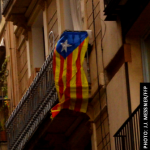BY AMANDA QUINN
October 1, 2017 marked the beginning of an intense social, political and constitutional crisis in Spain as Catalonia, a semi-autonomous region in the northeast of Spain, attempted to secede from the rest of the country through a controversial referendum. The situation spiraled into chaos as the Spanish government first declared the referendum illegal while the separatist regional administration in Barcelona moved forward with the process anyway. The vote resulted in an overwhelming victory for the separatists only to be dismissed by the government in Madrid and the separatist leadership charged with sedition and its leader fleeing to Belgium.
For some years, particularly in the wake of the economic crisis, Spain was one of a handful of Western European countries to struggle – indeed, between 2007 and 2012, each of the “PIIGS” (Portugal, Ireland, Italy, Greece, and Spain), representing some of the weakest economies on the continent, all experienced significant declines. However, since 2013 the picture has been significantly rosier for Spain, with the country’s scores having improved across almost all twelve of the Fragile States Index (FSI) indicators. That improving trend has been reversed in 2017, with Spain ranking as one of the most worsened countries on the FSI for the past 12 months. This worsening was led in particular by a change in the country’s State Legitimacy score, which worsened by a highly significant four point change. This sharp increase can be attributed to Catalonia’s move toward independence and the subsequent drastic actions by the Spanish government.
Despite Spain’s Constitutional Court declaring the referendum unconstitutional and illegal, it was held on October 1, 2017, whereupon Catalan authorities reported a 90% vote in favor of independence with turnout of more than 2.2 million Catalan voters. It is important to place these events in context – while the October vote marked a clear intensification of tensions between Catalan separatists and Spain’s government, the divisions between Catalonia and the rest of Spain date back hundreds of years. Catalonia’s latest push for independence was fueled by a combination of economic, cultural, and political factors.
In the more recent history of the Catalan independence movement, tensions between the region and the central government can be traced to the 2006 Statute of Autonomy of Catalonia. The statute was passed by the Catalan legislature, approved by Spain’s parliament, and then ratified in a referendum, giving the region more autonomy in many areas, including education, health, justice, and governance. Soon after the statute’s approval, one of Spain’s center-right political parties, the Popular Party, challenged it before Spain’s Constitutional Court. The Court debated the constitutionality of the statute for four years and in 2010 ruled to strike down parts of it, stating that reference to Catalonia as a nation has no legal bearing in Spain. While most of the statute’s 223 articles remained intact, the decision resulted in widespread protests in the region.
The Catalan independence movement has also been driven by economic and cultural factors. Catalonia is one of the wealthiest and most productive regions in Spain and is home to about 7.5 million people. The Catalan economy makes up about a fifth of Spanish GDP. Separatist sentiments were partially exacerbated by the 2008 financial crash, which resulted in the Spanish government instituting several austerity measures. These measures intensified already-existing beliefs that Catalonia financially supports the rest of Spain through high taxes and that this is financially detrimental to the region.
While these factors explain some of the drivers of Catalan secessionist sentiments in the lead-up to the October referendum, it is more difficult to explain the chaos that followed.
The Spanish government’s extreme reaction to the October referendum served only to escalate the situation. Spanish security forces utilized excessive force during the period of the referendum with raids on polling stations by riot police, who sometimes violently removed voters. According to some reports, thousands of votes could not be counted because ballots were confiscated by authorities and polling stations were forcibly closed.
In the days following the referendum, the Administration in Madrid continued its crackdown on Catalan separatists, with the imprisonment of eight former ministers of the Catalan government on charges of sedition and rebellion. The former Catalan president, Carles Puigdemont, fled the country. The Spanish government also invoked Article 155, a measure that allowed it to dissolve the Catalan regional government and impose direct rule on the semi-autonomous region.
Following these actions, thousands gathered in Barcelona to protest the police violence that occurred during the referendum. If the goal of security force action during the vote was to put a stop to Catalan nationalist sentiments in the region, it appeared to have had the opposite result. The severe response of the central government to Catalonia’s move toward independence only served to further solidify negative sentiments toward the central government in Madrid.
While the movement for Catalonia’s independence has been growing in recent years, Catalans are divided on the issue. The Catalan government’s Centre for Opinion Studies (Centre d’Estudis d’Opinió) conducted a poll in June that revealed that only 41.1% of those polled supported Catalan secession. This number suggests that the movement for Catalan secession could have fizzled, even after the referendum. Instead December’s Catalan parliamentary election saw the greatest success of pro-independence parties in their history.
If the Spanish Prime Minister, Mariano Rajoy, was hoping these elections would finally put an end to the Catalan independence movement, he was mistaken. Three pro-Catalan independence parties won a small majority, claiming 70 of 135 seats in the region’s Parliament. A final count of the vote revealed that voter turnout was at 82% for the parliamentary elections, a record for Catalonia, and that there were 2,079,340 votes for pro-independence parties. These numbers indicate that pro-secession sentiments have been solidified in the region and will have to be addressed by the central Spanish government moving forward.
As populist and nationalist sentiments continue to grow across the European continent, it is likely that the Spanish government has not heard the last from Catalonia.
